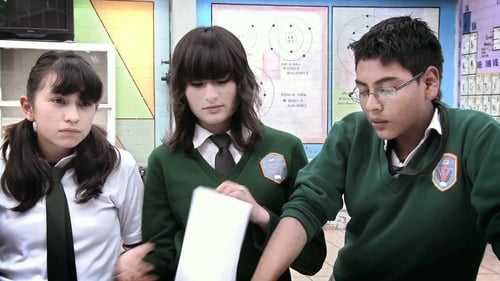Corazón del tiempo (2009)
Genre : Drama, Drama, Romance, Romance
Runtime : 1H 30M
Director : Alberto Cortés
Synopsis
A young woman in the southern Mexican region of Chiapas falls for a revolutionary fighting in the Zapatista conflict.

The life of the musician Juventino Rosas, who despite his talent lived an existence of misfortune and poverty.

The life of the musician Juventino Rosas, who despite his talent lived an existence of misfortune and poverty.

Miguel Sanabria is a masked philandering wrestler who will live great adventures to fulfill his dream of wrestling in Los Angeles. This is a hilarious comedy in which good and bad intentions, addictions, and sects, play a decisive role in our hero's attempts to cross the border.

Miguel Sanabria is a masked philandering wrestler who will live great adventures to fulfill his dream of wrestling in Los Angeles. This is a hilarious comedy in which good and bad intentions, addictions, and sects, play a decisive role in our hero's attempts to cross the border.

¿Y Tú, Cuánto Cuestas? (So, what's your price?), it seems to be the constant over this excellent documentary work, performed by Olallo Rubio, a young Mexican director. The movie shows two faces of the same issue: the American influence in the Mexican culture. you will remain thinking after the movie ends. Everything has a price? Everybody has a price?, so, What's your price?. Strong and ancient differences between two distant-neighbor countries are discussed under each opinion. Both Mexican and American-common persons give its particular point of view about the other, but also about themselves. Developed with a extremely low budget, but with inventive and imagination, this movie shows many of the key aspects in the Mexican-American relationship. However, the movie is not just a compilation of statistics, the producers manage to make it fun too. That's one of it's good points. But never the only one. Well developed, absolutely recommendable.

¿Y Tú, Cuánto Cuestas? (So, what's your price?), it seems to be the constant over this excellent documentary work, performed by Olallo Rubio, a young Mexican director. The movie shows two faces of the same issue: the American influence in the Mexican culture. you will remain thinking after the movie ends. Everything has a price? Everybody has a price?, so, What's your price?. Strong and ancient differences between two distant-neighbor countries are discussed under each opinion. Both Mexican and American-common persons give its particular point of view about the other, but also about themselves. Developed with a extremely low budget, but with inventive and imagination, this movie shows many of the key aspects in the Mexican-American relationship. However, the movie is not just a compilation of statistics, the producers manage to make it fun too. That's one of it's good points. But never the only one. Well developed, absolutely recommendable.

In the eyes of a foreigner practically any street of Mexico City’s Centro Histórico holds potential for a film. Life on the street deserves more than just the natural condition of observer anyone could have, it demands an extra attention. In a 100-meter radius, the sociological exuberance of the events going on is simply impossible to ignore. The street is a mise en scène in itself.

In the eyes of a foreigner practically any street of Mexico City’s Centro Histórico holds potential for a film. Life on the street deserves more than just the natural condition of observer anyone could have, it demands an extra attention. In a 100-meter radius, the sociological exuberance of the events going on is simply impossible to ignore. The street is a mise en scène in itself.

A very humble boy longs conditions make their first communion, but circumstances do not allow it until, after a tragic accident, Paco Malgesto and a group of people who help make his dream.

A very humble boy longs conditions make their first communion, but circumstances do not allow it until, after a tragic accident, Paco Malgesto and a group of people who help make his dream.

Panzazo! It reflects the reality of education in Mexico and demonstrates that Mexican society panzazo passes in an exclusionary system in which no lessons for life are achieved. We see in this movie moms, dads, principals, teachers, officials, union representatives and opinion leaders to draw a global picture that does not allow indifference. The data, interviews and what the students filmed with handheld cameras give rise to indignation and intelligent to realize the part that touches everyone contribute. The project ran for three years entering the reality of the students and their families, capturing the daily dynamics of schools in such diverse parts of the country such as Ciudad Juarez, the interior of Yucatan, Morelia, the mountains of Chiapas and Guerrero, as well as Naucalpan and Iztapalapa in the metropolitan area of Mexico City. EDIT: To clarify, "de panzazo" means "just squeaking through."

Panzazo! It reflects the reality of education in Mexico and demonstrates that Mexican society panzazo passes in an exclusionary system in which no lessons for life are achieved. We see in this movie moms, dads, principals, teachers, officials, union representatives and opinion leaders to draw a global picture that does not allow indifference. The data, interviews and what the students filmed with handheld cameras give rise to indignation and intelligent to realize the part that touches everyone contribute. The project ran for three years entering the reality of the students and their families, capturing the daily dynamics of schools in such diverse parts of the country such as Ciudad Juarez, the interior of Yucatan, Morelia, the mountains of Chiapas and Guerrero, as well as Naucalpan and Iztapalapa in the metropolitan area of Mexico City. EDIT: To clarify, "de panzazo" means "just squeaking through."

Diego's job is counting people as they enter a large government building. After work, he and his wife Blanca lie on the couch...

Diego's job is counting people as they enter a large government building. After work, he and his wife Blanca lie on the couch...

Don Alfonso is a deliveryman. He also plays marimbas, the traditional Guatemalan instrument. He is used to play a folkloric musical show in one of the fancy hotel of Guatemala City. He faces the population's lack of interest for his instrument, considered like out of date and old fashioned. Black is pioneer of the Heavy Metal Guatemalan underground stage. He also is also a doctor in the public hospital but nobody wants to be treated by him because of his long hair and his tattoos. When Don Alfonso and Black meet each other and decide to combine their talents and create a brand new project called Marimbas from Hell, they could never have imagined all the reactions they would provoke among the population.

Don Alfonso is a deliveryman. He also plays marimbas, the traditional Guatemalan instrument. He is used to play a folkloric musical show in one of the fancy hotel of Guatemala City. He faces the population's lack of interest for his instrument, considered like out of date and old fashioned. Black is pioneer of the Heavy Metal Guatemalan underground stage. He also is also a doctor in the public hospital but nobody wants to be treated by him because of his long hair and his tattoos. When Don Alfonso and Black meet each other and decide to combine their talents and create a brand new project called Marimbas from Hell, they could never have imagined all the reactions they would provoke among the population.

In the beautiful hills of the Copper Canyon in Chihuahua, Mexico, a young boy (Emilio) is adopted by the mailman (Teo). As part of their daily tasks, they not only deliver the mail but read letters to the villagers, as well as take dictation, since most are illiterate. Young Emilio quickly learns to read and write but feels saddened by the mostly difficult stories sent by relatives, that moved north to Denver, Colorado in pursuit of a better future. One day Teo becomes disabled and Emilio takes over the mail route and with great imagination, he changes the letters to happy and optimistic stories. Within days, the village is transformed. The elders, once hopeless, lonely and sad, are now happy and enthusiastic, enjoying the "supposed" success their loved ones write from the United States. But the enjoyment is short lived, as they realize that all the wonderful stories are the same...

In the beautiful hills of the Copper Canyon in Chihuahua, Mexico, a young boy (Emilio) is adopted by the mailman (Teo). As part of their daily tasks, they not only deliver the mail but read letters to the villagers, as well as take dictation, since most are illiterate. Young Emilio quickly learns to read and write but feels saddened by the mostly difficult stories sent by relatives, that moved north to Denver, Colorado in pursuit of a better future. One day Teo becomes disabled and Emilio takes over the mail route and with great imagination, he changes the letters to happy and optimistic stories. Within days, the village is transformed. The elders, once hopeless, lonely and sad, are now happy and enthusiastic, enjoying the "supposed" success their loved ones write from the United States. But the enjoyment is short lived, as they realize that all the wonderful stories are the same...

After being in a comma for 20 year, Lauro (Retes) wakes up in a very different Mexico than the one he lived on. Ideas, hopes, ways-of-life and customs have changed, and Mexicans of the nineties are strangers for a man sleeping since 1971. Lauro will have to deal with the changes brought by the History, and will have to accept that the future is never as we imagined it when we were young.

After being in a comma for 20 year, Lauro (Retes) wakes up in a very different Mexico than the one he lived on. Ideas, hopes, ways-of-life and customs have changed, and Mexicans of the nineties are strangers for a man sleeping since 1971. Lauro will have to deal with the changes brought by the History, and will have to accept that the future is never as we imagined it when we were young.









